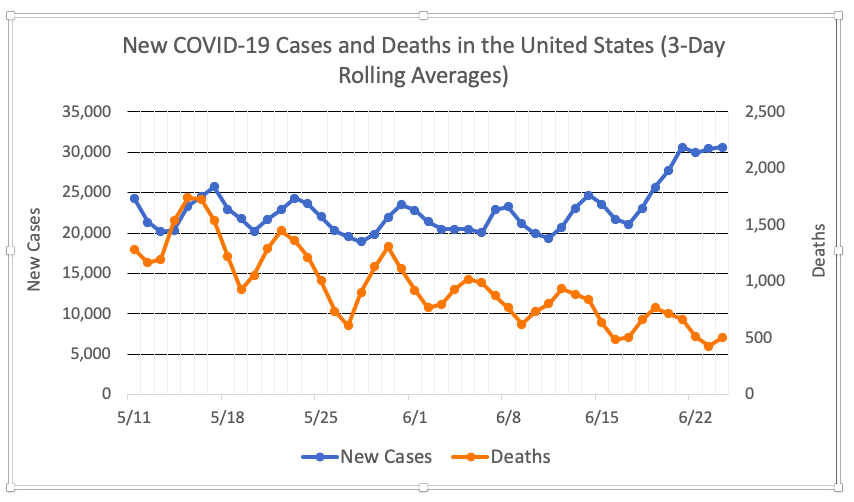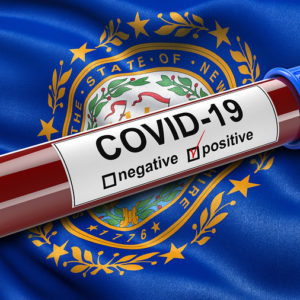June has brought a steady stream of good COVID-19 news to New Hampshire.
New cases and hospitalizations have tapered off, the positive test rate is steady near 2 percent and daily deaths have reached double digits just twice all month–more than 80 percent of them among residents of longterm care facilities, not the general public.
On Wednesday, State Health Commissioner Lori Shibinette announced that active hospitalizations are at their lowest point since early April.
For many states, though, recent surges in COVID-19 cases and hospitalizations make clear that the “first wave” of the virus is not over.
So far missing from the virus’s resurgence, however, is a corresponding increase in deaths, which continue to fall.
Whether the downward trend in deaths continues will be the key question in determining the true extent of the virus’ spread over the past several weeks.
Per the New York Times, more than 20 states are experiencing increases in new cases, and the United States set a new daily cases record of 36,880 on Wednesday.
At a campaign rally Saturday, and again on Tuesday, President Trump suggested that these spikes in cases are due to increased testing rather than an actual surge of the virus.
This explanation does not hold water, as many of the states with case surges are also seeing increases in their positive test rates. This means that the states’ surges in positive tests are outpacing the expansions of their testing capabilities.
Hospitalization numbers, which are unaffected by increased testing, also provide evidence of increased spread of the virus, though not quite to the same extent as new cases.
A CNBC analysis found that 14 states saw upticks in COVID-19 hospitalizations, and Axios reported that seven states “have set records for the number of people hospitalized with coronavirus.”
Meanwhile, deaths from the coronavirus have consistently fallen since their peak on April 18.

Deaths naturally lag behind cases, as the virus typically takes two to five weeks to kill an individual after infection. This lag has caused some public health experts, including Dr. Anthony Fauci, to raise concerns that the next few weeks will see surges in deaths corresponding with the case increases states are seeing now.
A NHJournal analysis of figures from Our World in Data, however, found that deaths have fallen more significantly in recent weeks than would be expected if they simply mirrored the case figures from several weeks earlier.
From June 17 to June 24, the three-day moving average of daily deaths fell slightly from 509 to 503. Three weeks earlier, from May 27 to June 3, the three-day moving average of daily confirmed new cases rose 4.9 percent, from 19,514 to 20,479.
This discrepancy was consistent across the two previous weeks as well:
From June 10 to June 17 deaths fell 30.7 percent, while the period three weeks earlier had just a 3.5 percent decline in cases, and the week of June 3 to June 10 saw an 8 percent decrease in deaths, while three weeks prior cases held steady.
These figures suggest that deaths are falling faster than cases, and that deaths are continuing to fall even as cases rise.
How could this be, without a cure for the virus?
Scott Gottlieb, former commissioner of the FDA, suggested last weekend that possible explanations for this phenomenon include “improvements in medical care, and more diagnosed cases occurring in milder disease and younger patients as older individuals protect themselves better.”
Research has established that younger people are much more likely to survive COVID-19, so if a greater share of the new positive tests is made up of young people, a lower death rate would be expected.
Comprehensive data on the average age of new COVID-19 cases tests is hard to come by, but a New York Times report on “the large number of cases turning up in young adults” in the South backs up Gottlieb’s hypothesis.
While certainly preferable to surges in cases within other age groups, increased cases among young people can still be dangerous.
Young people are very likely to survive the virus, but the COVID-19 mortality rate among those aged 18 to 49 is still significantly higher than that of the flu for the same age group.
Further, Dr. Fauci told Congress Tuesday that he expects increased spread from young people to older, more at-risk, individuals.
As some states respond to the surge in cases and hospitalizations by slowing or rolling back their reopenings, deaths will be the most important COVID-19 metric to watch in the coming weeks.
If they continue to fall, it will be an encouraging sign of progress against the virus.
Alternatively, an uptick in deaths in the coming weeks would be a grim sign that a nation ready to move on might be in for a rough summer.

